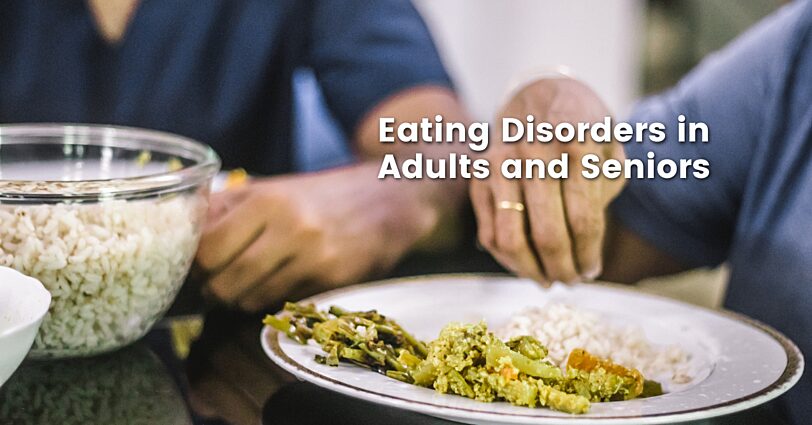
Eating disorders are mental health conditions characterized by abnormal attitudes and behaviors toward food, which can manifest in a variety of ways.
Eating Disorders and Comorbidities in Older Populations
Behaviors such as compulsive snacking and yo-yo dieting are unhealthy eating patterns but are not considered a mental health disorder, however, these behaviors may lead a person to have even more unrealistic expectations about their bodies and an unhealthy relationship with food/nourishment. It can impact a person’s sense of health and wellness and may cause frustration and increase their risk of certain conditions including obesity, diabetes, and high blood pressure (Healthline, 2017). In some cases, these eating and dieting behaviors may even increase a person’s risk of developing a full blown eating disorder.
Eating disorders are mental health conditions characterized by abnormal attitudes and behaviors toward food, which can manifest in a variety of ways. Eating disorder behaviors include restrictive eating, overeating, binge eating, purging, and compensatory behaviors such as excessive exercise or laxative use. They are often accompanied by feelings of distress, shame, guilt, and low self-esteem. Eating disorders have serious physical and psychological consequences, and can be life-threatening.
Eating disorders often co-occur with other mental health conditions including:
- Major depressive depression (MDD), anxiety disorders
- Substance use disorders
- Obsessive-compulsive disorder (OCD)
- Attention-deficit/hyperactivity disorder (ADHD)
- Autism spectrum disorder (ASD)
- Post-traumatic stress disorder (PTSD)
- Borderline personality disorder (BPD)
Eating disorders are often thought of as an issue that affects only adolescents and young adults, but they can also occur in older adults. Older adults with eating disorders may have a history of dieting or may have developed the disorder as a result of aging-related changes, including physical, emotional, and lifestyle changes. Symptoms of eating disorders in older adults may include drastic changes in appetite, preoccupation with weight and body image, and using food as a way to cope with emotions. Older adults may also experience additional medical complications due to malnutrition and/or metabolic changes due to aging.
Below provides an overview of a few common eating disorders, how they impact older adults, and treatment options.
- Avoidant Restrictive Food Intake Disorder (ARFID) is a disorder that affects the ability of an individual to consume a variety of foods in adequate amounts. It is most commonly seen in children and adolescents, but can also affect older adults as well. In older adults, ARFID can be caused by a number of factors, including medical conditions such as dementia, depression, stroke, or chronic pain. It can also be a result of physical changes in the body, such as changes in taste and smell, difficulty swallowing, or difficulty chewing. Additionally, ARFID can be caused by the side effects of certain medications or the fear of choking or gaining weight. In older adults, the symptoms of ARFID can include eating only a few types of food, avoiding social situations where food is involved, avoiding certain textures or tastes, and eating very small amounts of food. Other symptoms may include feelings of distress or anxiety around mealtimes, difficulty concentrating during meals, and weight loss. Treatment for ARFID in older adults will depend on the underlying cause. If the cause is medical, then treatment may involve treating the medical condition. If the cause is psychological, then treatment may include cognitive behavioral therapy or psychotherapy.
- While anorexia is most commonly associated with adolescents and young women, it can also affect older adults. Some contributing factors to anorexia in older adults include chronic medical conditions, medication side effects, psychological issues (e.g. depression, stress, trauma) and social issues (e.g. lack of support, isolation). It is also important to note that anorexia can sometimes be overlooked in older adults due to the assumption that it only affects younger individuals. Common signs and symptoms of anorexia in older adults include unintentional weight loss, changes in eating habits, obsessing over food, avoiding social situations involving food, and excessive exercise. If left untreated, anorexia can lead to serious health complications, including malnutrition, dehydration, fatigue, weakened bones, and an increased risk of infections. Treatment for anorexia in older adults may include a combination of nutritional counseling, psychotherapy, and medication.
- Bulimia nervosa is not as common among older adults as it is among younger adults, but it can still occur. Older adults with bulimia nervosa may have different symptoms than younger adults, as they may have a longer history of the disorder and more established patterns of behavior. Symptoms may include recurrent episodes of binge eating, purging behaviors (such as self-induced vomiting, use of laxatives or diuretics, or excessive exercise), and an intense fear of gaining weight or becoming fat. Older adults may also have difficulty controlling their eating behaviors and may experience feelings of guilt or shame about their eating habits. Treatment for older adults with bulimia nervosa typically involves psychotherapy, nutrition counseling, and medication management.
- Binge eating disorder is a relatively new diagnosis, and so far there is limited research on binge eating disorder in older adults. However, some studies have indicated that binge eating disorder can occur in older adults, especially those with a history of depression, anxiety, or other mental health issues. Older adults may also be more likely to engage in emotional eating as a way to cope with life changes, such as the death of a loved one or a move to a new setting like a nursing home. Additionally, older adults may be more likely to restrict their diets in an attempt to maintain a healthy weight, which can lead to binge eating when the restriction is relaxed. Treatment options for binge eating disorder in older adults may include cognitive-behavioral therapy, interpersonal therapy, and pharmacotherapy. Additionally, lifestyle modifications, such as increasing physical activity and making healthy dietary choices, can help to reduce symptoms.
I’ve included patient resources, additional readings, and a few Ted Talks about eating disorders below.
Patient Resource:
https://www.nationaleatingdisorders.org/help-support/contact-helpline
Additional Reading:
https://www.psychiatrictimes.com/view/eating-disorders-among-older-adults
Ted Talks about Eating Disorders:
https://www.ted.com/talks/anees_bahji_why_are_eating_disorders_so_hard_to_treat
https://www.ted.com/talks/kristie_amadio_it_s_time_to_do_eating_disorder_recovery_differently_here_s_how
https://www.ted.com/talks/viveca_lee_eating_disorders_a_mental_illness_not_a_lifestyle_choice
https://www.ted.com/talks/gabrielle_bernstein_removing_the_stigma_of_talking_about_eating_disorders
Work Cited
“10 Solid Reasons Why Yo-Yo Dieting Is Bad for You.” Healthline, 29 May 2017, www.healthline.com/nutrition/yo-yo-dieting#TOC_TITLE_HDR_11. Accessed 25 Apr. 2023.



